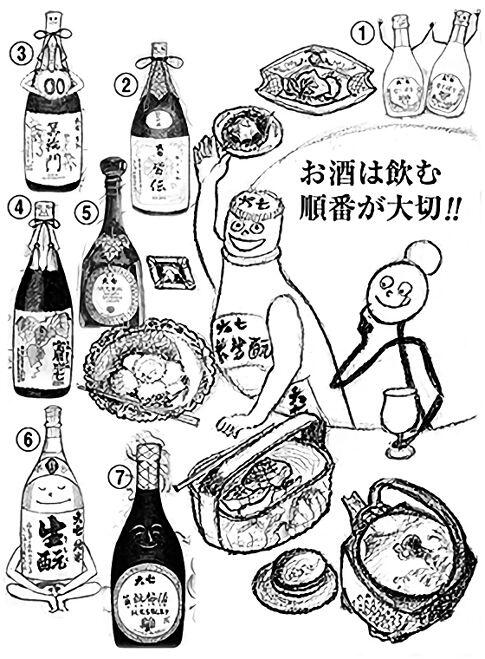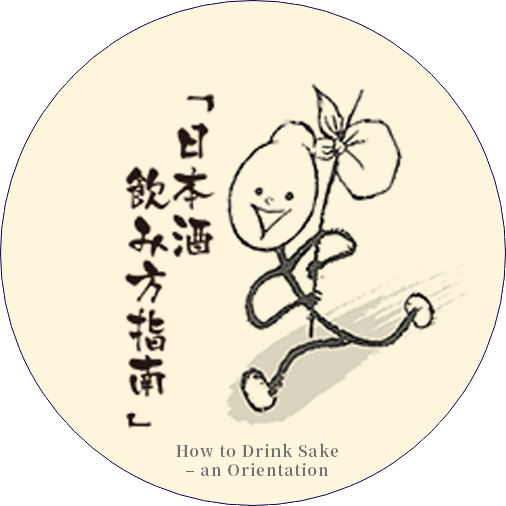| Yeast |
“The season for sake has arrived. Kimoto, I want to learn more about how to drink sake.” |
| Kimoto |
“Fine. I’ll give you a thorough orientation. What do you want to know first?” |
| Yeast |
“What is the best order, when ordering sake in a restaurant? In the case of wine, such an order does exist, doesn’t it?” |
| Kimoto |
“Yes, Western dinners start with light dishes like vegetables or seafood and then move on to heavier food like meat. To fit with that, one starts with light white wine and then changes to heavier red wine. The same way of thinking applies to Japanese food, as one starts with light dishes like sashimi, while grilled or simmered dishes come later. When you start with lighter sake and then change that into sake with a deeper taste, you can enjoy sake during the whole meal.” |
| Yeast |
“I see. When going from light to heavy, which sake could one actually drink?” |
| Kimoto |
“What about starting with a fruity and refreshing ginjo and later having a junmai sake with umami? Another possibility is to begin with a fresh sake and later change to a matured sake. Another good idea is to have cold sake first and afterwards warm sake. Another way of thinking is to gradually proceed to more expensive sakes.” |
| Yeast |
“That’s interesting. So there are more ways than one to think about the order.” |
|
 |
| Kimoto |
“Yes, but the most important thing is to match the sake to the food. When the taste of the sake and the food are an exact match, both become many times more delicious than when enjoyed separately. When deciding the order of drinking the sake, you have to be careful not to upset the pleasure of a great pairing.” |
| Yeast |
“What do you mean?” |
| Kimoto |
“For example, after a very sweet sake or a sake with a higher than usual alcohol percentage, the sensitivity of the tongue is impaired, and each following sake will have a thin taste. That’s why I don’t advise to make a toast with a sweet liqueur. It is also better not to have a unpasteurized, undiluted sake (namagenshu) with a high alcohol percentage immediately before in earnest tasting an elegant junmai daiginjo. When you take care to gradually change to sakes with a stronger taste, you’ll be able to enjoy the sake more.” |
| Yeast |
“I see. The right order of drinking sake is in fact the wisdom of how to enjoy sake.” |
| Kimoto |
“Yes, but I repeat again that the match between sake and food is the most important, the order of drinking comes in second place. Sometimes it’s good to do something unusual.” |
| Yeast |
“I understand. Kimoto, please teach me the order of drinking sake at a typical Daishichi dinner!” |
| Kimoto |
“OK. First we stimulate the appetite by Yukishibori, our lightly sparkling nigori sake. Then comes Kaiden (Masakura) with its smooth umami, and then Minowamon, which has a bright richness. The climax is formed by the full-bodied and powerful Horeki or Myoka Rangyoku. After this peak in ginjo-type sakes, one can change direction to sake with a deep umami, such as Junmai Kimoto “Yamada Nishiki” or Rakutenmei. And a fixed pairing with the dessert is our Kimoto Umeshu!” |
| Yeast |
“Wow, that sounds delicious! My mouth starts watering!” |
| Kimoto |
“An important characteristic of Daishichi is that our most expensive sakes, the junmai daiginjos, are strong enough to pair with the main dish. But that is an exception, as the usual junmai daiginjo is young and light, and not strong enough to pair with the main dish. In that case, it’s best to make a pairing with a rich junmai sake or a matured sake.” |
| Yeast |
“Thanks for all this valuable advice, I now feel confident to select the sake for a meal!” |
| Kimoto |
“No thanks, together we’ll continue mastering the best way of drinking sake!” |





